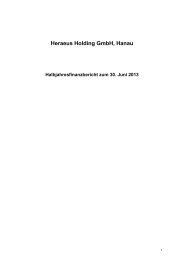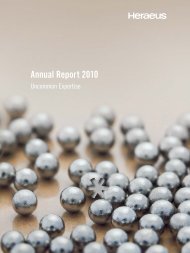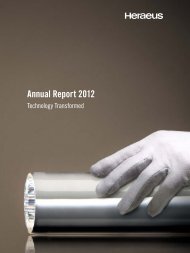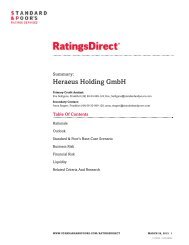english - About Heraeus
english - About Heraeus
english - About Heraeus
Create successful ePaper yourself
Turn your PDF publications into a flip-book with our unique Google optimized e-Paper software.
12<br />
In business combinations, the acquired assets and liabilities are recognized at fair value<br />
at the time of acquisition. The determination of the fair values at the time of acquisition,<br />
as well as the useful lives of the acquired intangible assets and property, plant, and equipment<br />
is based on assumptions. The measurement is largely based on projected cash flows.<br />
The actual cash flows may differ significantly from the cash flows used to determine<br />
the fair values. The purchase price allocation of material acquisitions is based on external<br />
independent appraisals. Measurements for business combinations are based on the information<br />
available on the acquisition date. In addition to assumptions about the development<br />
of future cash flows, valuations are significantly influenced by the discount interest rate.<br />
Goodwill has to be allocated to cash generating units and tested for impairment once a year.<br />
The carrying amount of cash generating unit is compared with its recoverable amount and<br />
an impairment loss is recognized where the recoverable amount is lower than the carrying<br />
amount. Impairment testing relies upon long-term earnings predictions based on overall<br />
economic trends. The weighted average cost of capital (WACC) plays an important role. The<br />
WACC is made up of the risk-free interest rate, the market risk premium, the beta factors,<br />
assumptions as to the spread for credit risk, as well as the debt ratio. Additional important<br />
assumptions are the predictions for the detailed planning period and the subsequently<br />
applied growth rates.<br />
Intangible assets and property, plant, and equipment: The estimated useful life and depreciation<br />
method chosen are based on historical values, plans, and estimates.<br />
Impairment tests on assets are required whenever certain triggering events indicate that<br />
an impairment may be necessary. External triggering events include, for example, changes<br />
in customer industries, technologies used, and economic downturns. Internal triggering<br />
events for an impairment include lower product profitability, planned restructuring measures,<br />
or physical damage to assets. Impairment tests are based on a comparison of the carrying<br />
amount of an asset and its recoverable amount. The recoverable amount is the higher of the<br />
fair value less costs and the value in use. The determination of value in use requires the<br />
estimation and discounting of cash flows. The estimation of cash flows and the assumptions<br />
used consider all information available on the respective balance sheet date on the future<br />
development of the operating business. Actual future developments may vary. An impairment
















